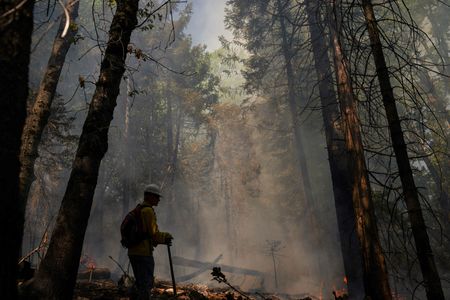By Nathan Frandino
GEORGETOWN, California (Reuters) – The prescribed burn begins on a California hill with a drip torch to light brush, needles and fallen branches, the flames spreading out on the forest floor far below the tree canopy.
Students on this Saturday class learn how to keep the burn under control, while others stand by ready to assist with water pumps, hand tools and first aid.
Teaching locals is exactly what Susie Kocher is hoping to accomplish through the El Dorado Amador Prescribed Burn Association. Founded in 2021, the association teaches private landowners about prescribed burns, including how to plan and carry them out safely.
Experts like Kocher and fire officials consider prescribed burns a vital tool to curb wildfire risks by preemptively burning dry timber and other fire fodder that could fuel the kind of out-of-control blazes California has seen in recent years.
“People have an innate fear of fire because it’s only been an enemy that’s been wiping out communities and it’s still doing that,” Kocher said. “But if you do it at the right time, under your own conditions, it can be your friend and it can treat the forest as opposed to destroying it.”
One of the students is Sarah Fischbach, a sixth-generation Californian who grew up burning piles of wood, leaves and other tree debris on her family’s 439-acre property in the Sierra Nevada foothills. But the recent fire conditions have been intimidating.
“We haven’t done any pile burns for probably 10 to 15 years with the way fires have been going. You know, recently we’ve been scared to, and we haven’t had really the knowledge to feel like we were doing it safely,” Fischbach said.
California last year launched a strategic plan for wildfire and forest resilience with the aim of expanding prescribed burns to 400,000 acres annually by 2025.
The Saturday class for two dozen volunteers – mostly college students and a few private landowners – at the Blodgett Forest Research Station west of Lake Tahoe turned out just as the experts had hoped.
“We are seeing really nice fire behavior. It’s consuming a lot of material on the ground, a lot of fuel and kind of cleaning out the understory. But we’re not seeing it get into the canopies of our trees, which is kind of exactly what we’re looking for,” said Ariel Roughton, a research forest manager.
Along the perimeter, Cathy Mueller stood watch as the fire crept downhill, learning how she should burn her own four-acre property, a practice she believes California needs to do more.
“California is meant to burn, and we’ve been suppressing fire for so long that the buildup of fuels is kind of an emergency state right now,” Mueller said.
“And so as individual homeowners, if we can take care of our individual properties and reduce the fuels both through like mechanical means and broadcast burning, it makes our neighborhoods safer.”
(Reporting by Nathan Frandino; Writing by Mary Milliken; Editing by David Gregorio)





